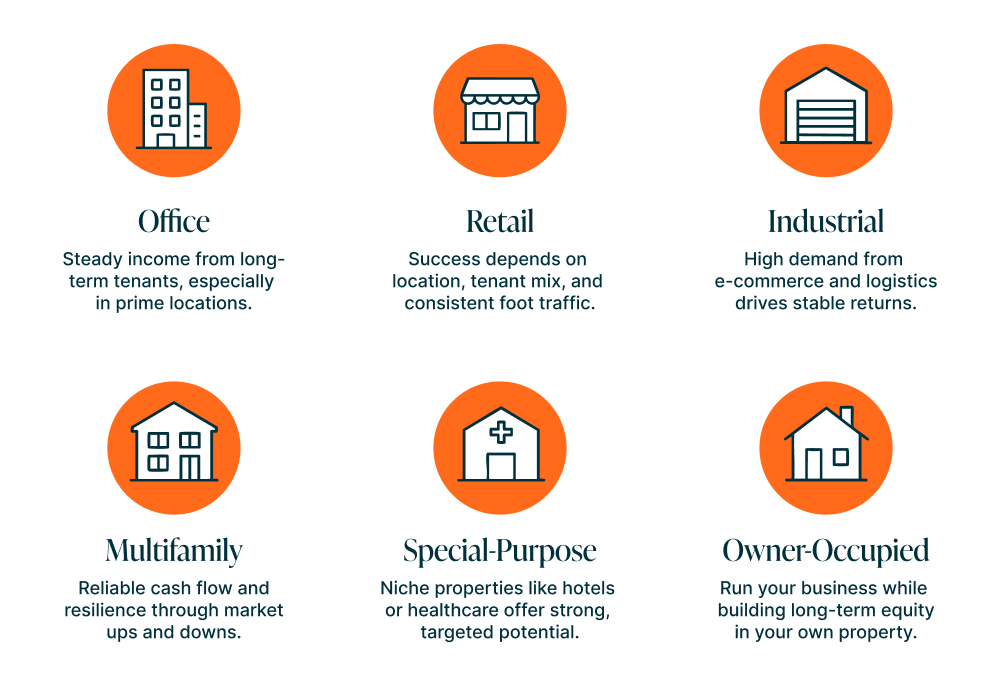Commercial real estate can be a powerful way to grow wealth, generate income, and diversify your investment portfolio. With careful planning, clear goals, and the right team of professionals, you can navigate this asset class with confidence and discipline. Here’s what to remember:
- Set clear goals: Identify your top priorities, income, appreciation, or tax benefits, and establish measurable targets that align with your risk tolerance.
- Analyze deals carefully: Evaluate market trends, location quality, and key financial metrics like NOI, cap rate, and cash-on-cash return before committing.
- Secure financing strategically: Understand your options, from traditional bank loans to alternative sources, and prepare documentation to maximize terms.
- Manage risk with due diligence: Conduct property inspections, legal checks, and system evaluations to avoid surprises.
- Build a strong professional team: Include a CFP® professional, broker, attorney, and property manager to guide decisions and protect your investment.
- Consider both direct and indirect investments: Direct ownership offers control and higher potential returns, while REITs and funds provide professional management, diversification, and easier liquidity.
- Align investments with your broader financial plan: Ensure each property fits your long-term wealth goals and complements your overall portfolio.
How to invest in commercial real estate
Commercial real estate can be a powerful tool to grow and diversify your wealth. Unlike residential property, these investments—think office buildings, retail centers, or warehouses—are designed to generate consistent rental income while building long-term value.
But success in this space isn’t just about buying the right property. Before you buy, you need to understand the fundamentals: how cash flow works, what drives property values, and the strategies that protect you from unnecessary risk. But with the right approach, investing in commercial real estate can provide both stability and growth in your broader financial plan.
At Domain Money, we believe you deserve to make these decisions with confidence. That means clear guidance, practical strategies, and advice tailored to your goals, not generic one-size-fits-all financial tips.
Why commercial real estate is a great investment
Commercial real estate properties offer unique advantages that set them apart from traditional residential properties. If you’re looking for stronger cash flow, longer-term stability, and valuable tax benefits, this asset class can be a powerful addition to your portfolio.
Steady, reliable income
One of the biggest appeals is income potential. While residential leases often last a year, commercial leases usually span 3 to 10 years, depending on property type and tenant agreement. That means fewer vacancies, less tenant turnover, and more predictable cash flow. In many cases, tenants also take on responsibility for maintenance and repairs, reducing your out-of-pocket expenses and management headaches.
Tax advantages that work for you
Commercial real estate also comes with meaningful tax benefits. You can deduct expenses like mortgage interest, depreciation, and operating costs, helping to reduce your taxable income. And with strategies such as a 1031 exchange, you can even defer capital gains when you sell and reinvest. With smart planning, these benefits can enhance your long-term returns.
Different property types

Commercial real estate isn’t one-size-fits-all. Each property type has its own strengths, challenges, and income potential. Understanding the differences helps you align your commercial real estate investments with your goals, risk tolerance, and time horizon.
Office properties
Office buildings offer reliable income through multi-year leases, particularly in prime business districts. While trends like remote work have shifted tenant needs, spaces with flexible layouts, modern infrastructure, and amenities like parking and high-speed internet remain highly attractive to companies seeking a professional presence.
Retail properties
Retail properties succeed when location, tenant mix, and local demographics align. Centers anchored by essential services, like grocery stores or pharmacies, tend to remain stable even during downturns, while properties relying on discretionary spending can be riskier. Smart investment decisions focus on foot traffic, tenant quality, and long-term lease stability.
Industrial properties
Warehouses, distribution centers, and flex spaces have surged in demand due to e-commerce growth and evolving supply chains. These properties usually feature longer leases and lower maintenance responsibilities, often with tenants covering property taxes, insurance, and upkeep. This makes industrial real estate a resilient, predictable source of income.
Multifamily properties
Apartment complexes with multiple units provide steady cash flow and built-in diversification, since vacancy in one unit doesn’t erase all income. They’re generally recession-resistant, and investors can increase returns through property improvements, better management, or strategic upgrades, making multifamily a smart entry point into commercial real estate.
Special-purpose properties
Special-purpose properties are built for a unique function, such as hotels, medical offices, or car washes. Their specialized design limits alternative uses, but strong demand in niche markets can yield excellent returns. Careful evaluation of market trends, occupancy, and operational complexity is key to success in this sector.
Owner-occupied properties
Owner-occupied commercial real estate allows you to run your business while building equity in the property. This approach can reduce lease costs, offer tax advantages, and create long-term value. Balancing operational needs with investment strategy ensures the property works for both your business and your financial goals.
Different investment options
When it comes to investing in real estate, you have two main paths: direct ownership or indirect investments. Understanding the differences helps you choose the approach that fits your goals, risk tolerance, and lifestyle.
Direct ownership
Owning a property directly gives you full control over decisions: tenant selection, property improvements, and management strategies. It can deliver higher returns and greater equity growth, but it also requires time, capital, and hands-on involvement. This approach works best if you want an active role in your investments and are comfortable managing operational responsibilities.
Indirect investments
Indirect options, such as REITs (Real Estate Investment Trusts) or private equity funds, allow you to invest in commercial real estate without managing the property yourself. These vehicles provide professional management, portfolio diversification, and easier liquidity, though you give up some control and may earn slightly lower returns compared to direct ownership.
Many investors use a mix of both strategies to balance control, risk, and cash flow. A CFP® professional at Domain Money can help you determine the right blend, ensuring your commercial real estate investments fit seamlessly within your broader financial plan.
How to set clear investment goals
Successful commercial real estate investing starts with a clear plan. Use these steps to define goals that guide your decisions:
1 Identify your primary objective
- Steady monthly income to supplement or replace your salary?
- Long-term appreciation to grow wealth for retirement?
- Tax advantages to optimize your overall portfolio?
- Knowing your top priorities gives your strategy direction.
2 Set measurable targets with realistic timelines
- Avoid vague goals like “make money in real estate.”
- Example targets: “Generate $5,000 in monthly passive income within five years” or “Build a $2 million commercial real estate portfolio by age 50.”
- Concrete goals help guide property selection, financing, and growth pace.
3 Understand your risk tolerance
- Commercial real estate ranges from low-risk, steady-income properties to high-risk, high-reward opportunities.
- Consider your age, income stability, and overall financial picture.
- Align your investment approach with both your goals and comfort level.
4 Align with your broader financial plan
- A flat-fee CFP® professional at Domain Money can help ensure your commercial real estate goals complement your full financial picture.
How to find and analyze deals
Finding profitable commercial real estate opportunities requires strategy, patience, and careful evaluation. The best deals rarely appear on public listing sites; they come from networking, direct outreach, and working with brokers who understand your goals.
Build your network
Start by connecting with commercial real estate brokers in your target markets. They often know about properties before they hit the open market. Be clear about what you’re looking for (property type, size, location, and budget), so brokers can bring you the right opportunities. Attend local investment meetings and join online forums to expand your network and discover off-market deals.
Assess the market and location
The right location can make or break your investment. A strong property in a declining market may underperform, while an average property in a thriving area can exceed expectations.
Macro-level insights: Examine population growth, employment trends, and major employers. Growing populations drive demand, while diverse industries provide stability. Check local infrastructure projects and business-friendly policies; they can signal future market strength.
Micro-level insights: Look closely at the neighborhood. Retail properties need high foot traffic and complementary businesses nearby. Office spaces should be accessible, with parking and amenities that attract quality tenants. Industrial sites benefit from proximity to highways, ports, and appropriate zoning.
Track key economic indicators like rent growth, vacancy rates, and new construction. Rising rents and low vacancies suggest strong demand, while absorption rates indicate how quickly new space is leased, helping you identify optimal entry points.
Evaluate the deal's financial metrics
Numbers tell the real story. Financial analysis ensures a property aligns with your portfolio and goals.
Net Operating Income (NOI): Start by subtracting operating expenses from gross rental income. Verify seller-provided numbers, as costs like maintenance, management, and property taxes can be understated.
Capitalization Rate (Cap Rate): Divide NOI by the purchase price to estimate the property’s return. Lower cap rates often indicate premium properties in strong markets, while higher rates can signal either opportunity or additional risk.
Cash-on-Cash Return: Measure the actual return on your invested capital by dividing annual pre-tax cash flow by your total cash investment (including down payment and closing costs). Most investors aim for 8–12%, helping you compare real estate returns to other investment opportunities.
By combining thorough market research with disciplined financial analysis, you can confidently evaluate deals and select properties that fit your strategy and risk tolerance.
How to secure financing
Financing commercial real estate is a different game from residential mortgages. Lenders focus on the property’s income potential rather than just your personal finances. Understanding your options helps you structure deals strategically and use leverage to maximize returns.
Traditional bank loans
Banks are the most common source of financing. Expect 20–30% down payments, 5–10 year loan terms, and amortization periods up to 25 years. Rates depend on property type, location, your experience, and overall financial strength. Banks favor stabilized properties with reliable tenants and a proven income history.
Alternative financing options
You have other paths too:
- Credit unions: Competitive rates and flexible terms.
- Life insurance companies: Long-term financing for high-quality properties.
- Commercial mortgage-backed securities (CMBS): Non-recourse loans, but with less flexibility.
- Hard money lenders: Short-term funding for value-add projects needing quick closings.
A CFP® professional at Domain Money can help you weigh these options against your investment strategy and overall financial picture.
Be prepared
Lenders want to see detailed business plans, property operating statements, and your financial statements. Strong credit, cash reserves, and real estate experience increase your chances of favorable terms. Cultivate relationships with multiple lenders before you need a loan—it creates competition and ensures you secure the best available terms.
How to manage risk and due diligence
Most commercial real estate investors already know the importance of thorough due diligence. Spotting potential issues early protects your returns and sets you up for success.
Physical inspections
Hire qualified inspectors to check the structure, roof, mechanical systems, and parking. Environmental assessments can reveal hidden liabilities. Factor repair costs into your analysis, as small issues can add up.
Legal and compliance checks
Ensure clean ownership with title reviews and insurance. Confirm property boundaries with surveys. Check zoning rules to ensure current use is legal and future plans are possible. This can also reveal development opportunities.
Property systems
Evaluate HVAC, electrical, and plumbing systems. Older buildings may need updates or replacements. Knowing system conditions helps prevent unexpected, costly surprises.
How to build a team of professionals
A strong professional team can make the difference between a good investment and a great one. No single investor has all the expertise needed to evaluate properties, structure deals, manage operations, and navigate legal matters. The right team saves you money, reduces risk, and uncovers opportunities you might miss on your own.
1. CFP® professional
A Domain Money CFP® professional helps you connect your real estate strategy to your overall financial plan. They clarify goals, assess risk, and run the numbers so every property decision fits your long-term wealth strategy.
Think of them as your financial compass, guiding your investments with clarity and confidence.
2. Commercial real estate broker
Start with a broker who knows your target market and property type. They provide insights, access to off-market deals, and negotiation expertise.
Look for a partner, not just a transaction facilitator, someone invested in your long-term success.
3. Commercial real estate attorney
A skilled attorney protects your interests in every transaction. They review contracts, identify potential pitfalls, and set up the proper legal structures.
While fees may feel high upfront, they’re minor compared to the cost of legal mistakes.
4. Property manager
A quality property manager handles daily operations so you can focus on strategy. They maintain the property, manage tenants, and maximize income.
Choose carefully! Check references, understand fees, and look for someone aligned with your investment goals.
Making smart moves in commercial real estate
Learning how to invest in commercial real estate can open up a powerful path to long-term wealth, from office buildings to industrial warehouses. Success comes from setting clear goals, analyzing deals carefully, and working with the right professionals—brokers, attorneys, property managers, and a CFP® professional to guide you through each step.
Whether you choose direct ownership or indirect investments like REITs, due diligence is key. Understanding market trends, financial metrics, and property conditions protects your investment and positions you for sustainable income and growth.
At Domain Money, our flat-fee, CFP® professional-led approach helps you integrate commercial real estate into your broader financial strategy. Start with a free strategy session to turn your goals into an actionable plan and move confidently toward long-term financial independence.
Frequently Asked Questions (FAQs):
Is it worth it to invest in commercial real estate?
Yes, it can be. Commercial properties can offer higher income and long-term growth than residential real estate, but they come with greater complexity and risk. Understanding your goals and doing thorough research is key to success.
What is the 7% rule in real estate?
The “7% rule” is a quick rule of thumb some investors use to gauge potential rental returns, but it’s not an official valuation method and shouldn’t replace a full financial analysis. It helps you screen potential deals, though detailed analysis is always necessary before investing.
How much money do I need to invest in commercial real estate?
It depends on your approach. You can start with REITs for as little as a few hundred dollars, while direct commercial property ownership typically requires tens or hundreds of thousands. Align your investment size with your goals, risk tolerance, and available capital.
What type of commercial property tends to perform well?
Multifamily, industrial, and self-storage properties often perform well. They benefit from steady demand, consistent cash flow, and long-term appreciation potential, making them attractive for many investors.









